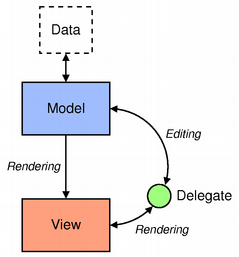Model/View Programming
IntroductionQt 4 introduces a new set of item view classes that use a model/view architecture to manage the relationship between data and the way it is presented to the user. The separation of functionality introduced by this architecture gives developers greater flexibility to customize the presentation of items, and provides a standard model interface to allow a wide range of data sources to be used with existing item views. In this document, we give a brief introduction to the model/view paradigm, outline the concepts involved, and describe the architecture of the item view system. Each of the components in the architecture is explained, and examples are given that show how to use the classes provided. The Model/View ArchitectureModel-View-Controller (MVC) is a design pattern originating from Smalltalk that is often used when building user interfaces. In Design Patterns, Gamma et al. write:
If the view and the controller objects are combined, the result is the model/view architecture. This still separates the way that data is stored from the way that it is presented to the user, but provides a simpler framework based on the same principles. This separation makes it possible to display the same data in several different views, and to implement new types of views, without changing the underlying data structures. To allow flexible handling of user input, we introduce the concept of the delegate. The advantage of having a delegate in this framework is that it allows the way items of data are rendered and edited to be customized.
Generally, the model/view classes can be separated into the three groups described above: models, views, and delegates. Each of these components are defined by abstract classes that provide common interfaces and, in some cases, default implementations of features. Abstract classes are meant to be subclassed in order to provide the full set of functionality expected by other components; this also allows specialized components to be written. Models, views, and delegates communicate with each other using signals and slots:
ModelsAll item models are based on the QAbstractItemModel class. This class defines an interface that is used by views and delegates to access data. The data itself does not have to be stored in the model; it can be held in a data structure or repository provided by a seperate class, a file, a database, or some other application component. QAbstractItemModel provides an interface to data that is flexible enough to handle views that represent data in the form of tables, lists, and trees. However, when implementing new models for list and table-like data structures, the QAbstractListModel and QAbstractTableModel classes are better starting points because they provide appropriate default implementations of common functions. Each of these classes can be subclassed to provide models that support specialized kinds of lists and tables. Qt provides some ready-made models that can be used to handle items of data:
If these standard models do not meet your requirements, you can subclass QAbstractItemModel, QAbstractListModel, or QAbstractTableModel to create your own custom models. ViewsComplete implementations are provided for different kinds of views: QListView displays a list of items, QTableView displays data from a model in a table, and QTreeView shows model items of data in a hierarchical list. Each of these classes is based on the QAbstractItemView abstract base class. Although these classes are ready-to-use implementations, they can also be subclassed to provide customized views. DelegatesQAbstractItemDelegate is the abstract base class for delegates in the model/view framework. A default delegate implementation is provided by the QItemDelegate class, and this is used as the default delegate by Qt's standard views. Convenience ClassesA number of convenience classes are derived from the standard view classes for the benefit of applications that rely on Qt's item-based item view and table classes. They are not intended to be subclassed, but simply exist to provide a familiar interface to the equivalent classes in Qt 3. Examples of such classes include QListWidget, QTreeWidget, and QTableWidget; these provide similar behavior to the QListBox, QListView, and QTable classes in Qt 3. These classes are less flexible than the view classes, and cannot be used with arbitrary models. We recommend that you use a model/view approach to handling data in item views unless you strongly need an item-based set of classes. The Model/View ComponentsThe following sections describe the way in which the model/view pattern is used in Qt. Each section provides an example of use, and is followed by a section showing how you can create new components.
See also the list of Model/View Classes. Related Examples[Next: Using Models and Views] |
| Cette page est une traduction d'une page de la documentation de Qt, écrite par Nokia Corporation and/or its subsidiary(-ies). Les éventuels problèmes résultant d'une mauvaise traduction ne sont pas imputables à Nokia. | Qt 4.0 | |
| Copyright © 2012 Developpez LLC. Tous droits réservés Developpez LLC. Aucune reproduction, même partielle, ne peut être faite de ce site et de l'ensemble de son contenu : textes, documents et images sans l'autorisation expresse de Developpez LLC. Sinon, vous encourez selon la loi jusqu'à 3 ans de prison et jusqu'à 300 000 E de dommages et intérêts. Cette page est déposée à la SACD. | ||
| Vous avez déniché une erreur ? Un bug ? Une redirection cassée ? Ou tout autre problème, quel qu'il soit ? Ou bien vous désirez participer à ce projet de traduction ? N'hésitez pas à nous contacter ou par MP ! | ||
Copyright © 2000-2012 - www.developpez.com




















